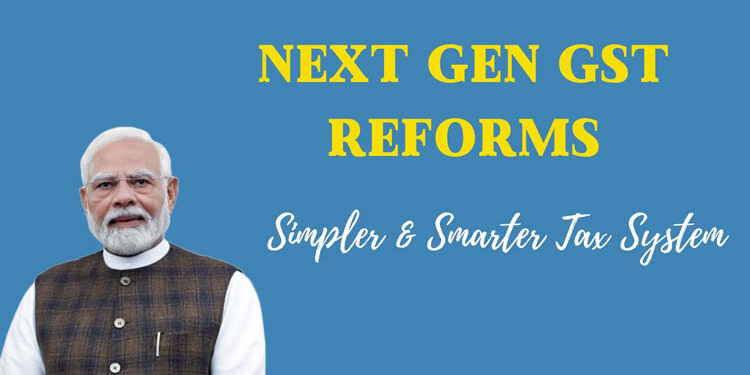Jayant Khobragade, Indian Ambassador in Spain
Next Gen GST Reforms

The Government of India in its 56th Meeting of the Goods and Services Tax (GST) on 3 September 2025 in New Delhi approved a sweeping reform package of taxation (Next Gen GST Reforms).
This reform which came into effect on 22 September 2025 marks a significant overhaul of indirect taxation in India since its first roll-out in July 2017 and promises to simplify compliance, reduce costs and make India’s vast market more attractive to both domestic and global investors.
In his 2025 Independence Day address, Prime Minister Narendra Modi announced that “The government will bring Next-Generation GST reforms, which will bring down tax burden on the common man. It will be a Diwali gift for you.” Prime Minister Modi announced that the reforms, would directly benefit the common man, farmers, Micro Small Medium-sized Enterprises (MSMEs), women, youth, and middle-class families, while strengthening India’s long-term growth. In line with Prime Minister Modi’s vision, the GST Council recommended a comprehensive reform package that included rate rationalization with a simplified two-slab structure (5% and 18%), sweeping rate reductions across sectors, with focus on common-man, labour-intensive Industries, farmers and agriculture, health, key drivers of the economy.
Just a few days back, Diwali, the festival of lights, was celebrated in India and many parts of the world. In many regions of India, the festival coincides with the beginning of the new year as per local calendars. The most important day is offering prayers to Goddess Laxmi, who is Goddess of Wealth and Prosperity. On the occasion of Diwali, Indians do buy new things like costumes, jewellery etc. This year the Diwali witnessed sales worth US$ 68.77 billion in goods, as compared to US$ 61.38 billion last year, marking a growth of more than 10%.
How did it happen?
It is generally attributed by all analysts to reduction of goods and services tax (GST) rates by Government of India. A call by Prime Minister Narendra Modi of ‘Vocal for Local’ and ‘Swadeshi (self reliance)’, Diwali resonated well with the public. As is known that the Indian economy has grown by 7.6 % , in the first half of 2025. The consumption by the Indian citizens still find more growth.
What are the reforms?
Next Gen GST Reforms mark a major simplification of the GST structure. The shift to a two-slab system of 5% and 18%, removing the earlier 12% and 28% rates, will make taxation more transparent and easier to follow. At the same time, a 40% on luxury and sin goods such as tobacco, aerated drinks, high-end cars, yachts, and private aircraft ensures fairness and revenue balance. Additionally, registration and return filing have been simplified, refunds made faster, and compliance costs reduced, easing the burden on businesses, especially MSMEs and startups. Under the new system, businesses can now register in as little as three days, while Exporters receive 90% upfront provisional refunds, easing cash flow constraints.
Next Gen GST Reforms and its relevance for Spain
While Next Gen GST Reforms are primarily an Indian reform, its implications extend well beyond India’s borders. The reforms create a more predictable, transparent, and business-friendly environment for major foreign investors like Spain, enhancing India´s appeal as a preferred global investment destination. European companies, particularly from Spain, can benefit in several ways: Automotive Sector: Spanish car-makers and component suppliers who see India not only as a growing market but also a export hub can benefit from tax rates on vehicles dropping from 28% to 18%, and with faster refunds for exporters. Renewable Energy and Infrastructure: Spain is a global leader in solar and wind energy. India’s ambitious green transition,backed by tax simplification under the new GST Reforms are bound to fuel a stronger collaboration in this sector. Lower compliance costs, faster approvals, and reduced cash flow barriers will encourage Spanish green energy firms to scale operations in India. Technology and Services: Digital-first compliance not only reduces red tape but also opens doors for Spanish IT and consulting firms to provide solutions in AI, automation, and compliance technology, aligning with India’s new digital tax infrastructure. Housing and Consumer Goods: With reduced GST on electronics, appliances, and building materials, Spanish firms in consumer durables and construction materials will find a more buoyant Indian market for exports and joint ventures.
What Next Gen GST Reforms means for India
When GST was introduced in 2017, it was hailed as a revolution: a single indirect tax replacing a web of central and state levies. Over the past eight years, GST has created a more integrated Indian economy and provided governments with predictable revenues and has become the backbone of indirect taxation in India, creating a common market across states and ensuring more predictable revenues. With Next Gen GST Reforms, the government now seeks to make the system more business-friendly, digital and fair. These reforms not only seek to reduce the financial burden on households and businesses, but also strengthen India’s vision of inclusive growth, sustainability, and empowerment of youth. For global partners, these reforms mean greater predictability, reduced compliance costs and a more business friendly investment environment, especially in sectors like automotives, consumer goods, infrastructure and renewable energy.
Conclusion
The 2025 GST reforms mark a transformative chapter in India’s journey toward inclusive economic growth and youth empowerment. By rationalising rates across diverse industries, the government has not only eased the cost of living but also fostered new opportunities for startups, MSMEs, and job seekers. The reduction in taxation for essential goods, services, and emerging technologies underscores a forward-looking approach that combines affordability with competitiveness. These measures will stimulate domestic manufacturing, support traditional industries, and encourage innovation, while also improving public health, education, and mobility. Collectively, the reforms reaffirm India’s commitment to making taxation simpler, fairer, more growth-oriented and a more business firendly Investment environment.







